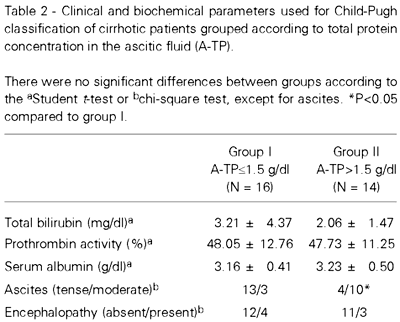Cirrhotic patients (23 with alcoholic cirrhosis, 5 with posthepatitic cirrhosis and 2 with cryptogenic cirrhosis) with ascites and portal hypertension were studied and divided into two groups corresponding to high or low risk to develop spontaneous bacterial peritonitis (SBP) related to the concentration of total protein in the ascitic fluid (A-TP): group I (high risk): A-TP<FONT FACE="Symbol">£</font>1.5 g/dl and group II (low risk): A-TP>1.5 g/dl. Fibronectin (FN), C3 and C4 concentrations were measured by radial immunodiffusion while total protein was measured by the biuret method. The mean values (group I vs group II) of C3 (12.59 ± 4.72 vs 24.53 ± 15.58 mg/dl), C4 (4.26 ± 3.87 vs 7.26 ± 4.14 mg/dl) and FN (50.47 ± 12.49 vs 75.89 ± 24.70 mg/dl) in the ascitic fluid were significantly lower (P<0.05) in the group considered to be at high risk for SBP. No significant difference was observed in the plasma/ascites fibronectin ratio (3.91 ± 1.21 vs 3.80 ± 1.26) or gradient (131.46 ± 64.01 vs 196.96 ± 57.38) between groups. Fibronectin in ascites was significantly correlated to C3 (r = 0.76), C4 (r = 0.58), total protein (r = 0.73) and plasma FN (r = 0.58) (P<0.05). The data suggest that the FN concentration in ascites is related to the opsonic capacity of this fluid, and that its concentration in the ascitic fluid may be a biochemical risk factor indicator for the development of spontaneous bacterial peritonitis
fibronectin; spontaneous bacterial peritonitis; ascites





